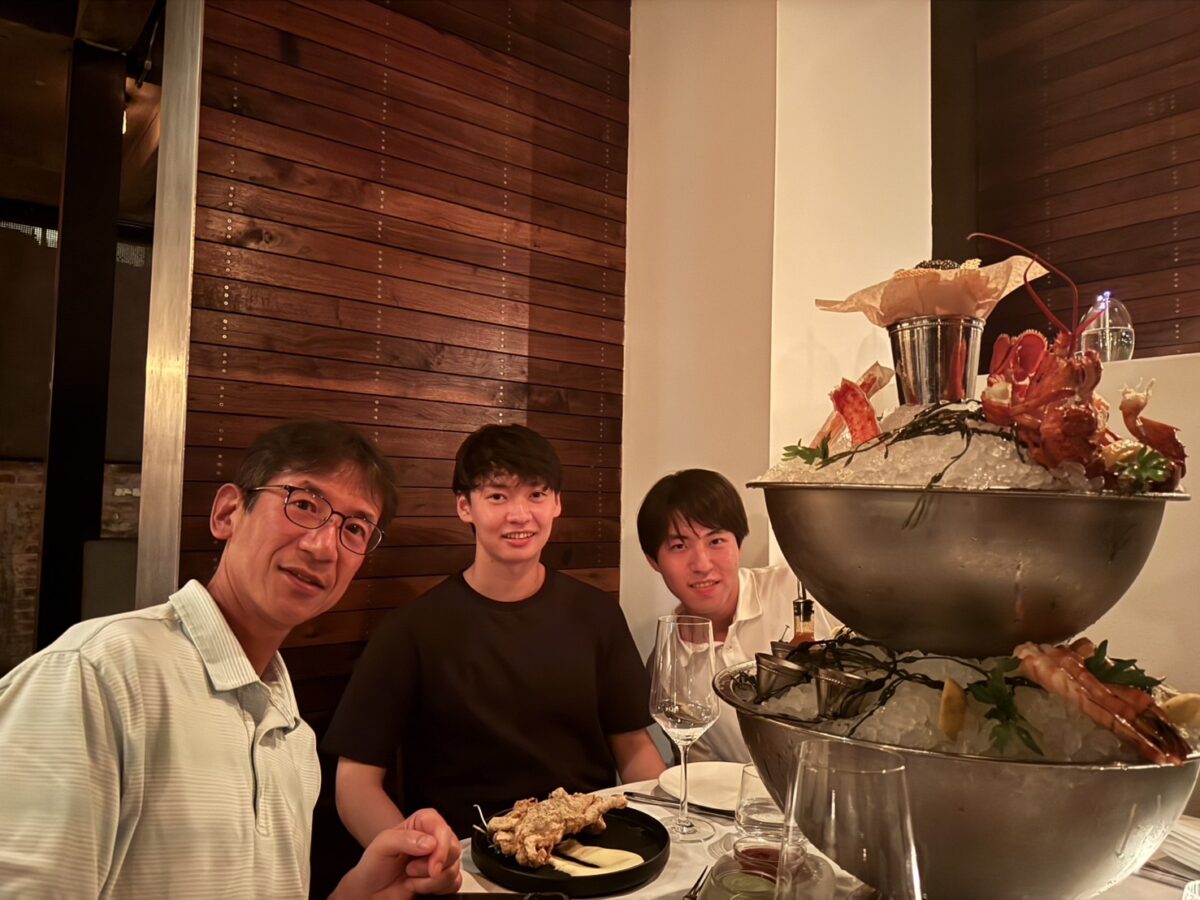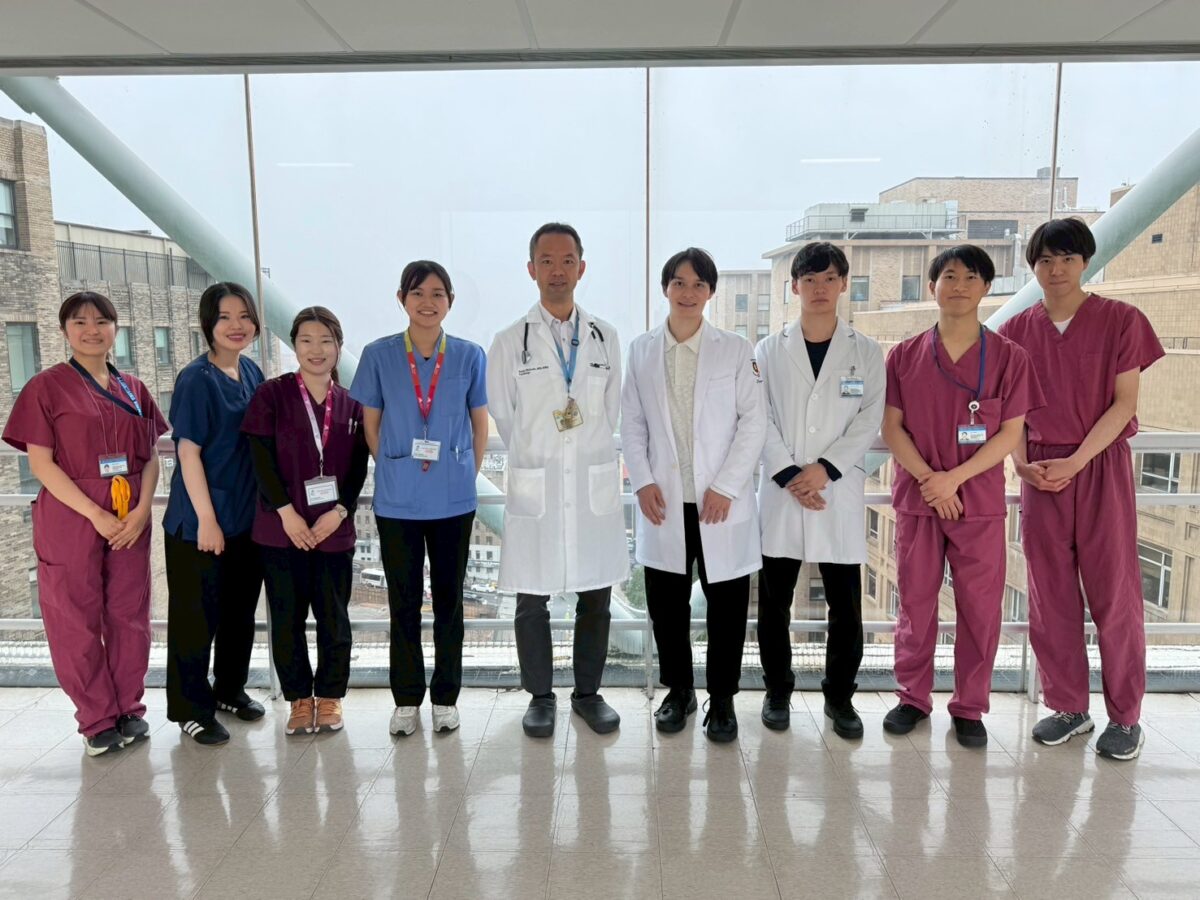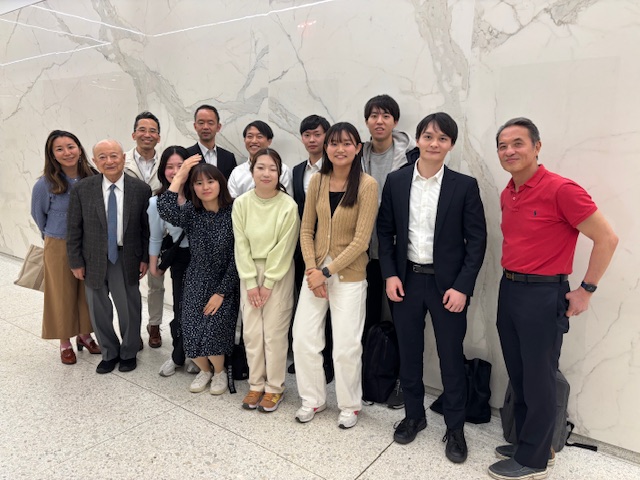

Reflections from Hitoki Kato, a 6th year medical student at University of Tokyo:
During my clinical training in Tokyo, I was lucky to meet Dr. Yasutaka Hirata, a pediatric cardiac surgeon in Japan who kindly agreed to introduce me to Dr. Hiroo Takayama at Columbia University/New York Presbyterian Hospital (NYP). Thanks to Dr. Hirata’s recommendation, I had the privilege of participating in a four‑week observership under Dr. Takayama’s supervision. From the moment I arrived at NYP, I was struck by the warmth and generosity of the entire community.
Shortly after my observership began, I learned that several other exchange students were also rotating at NYP. One of them, a Japanese medical student working in cardiac surgery, kindly invited me to a dinner hosted by the Japanese Medical Society of America (JMSA). Although my participation was arranged at the last minute, Dr. Yuichi Shimada – an attending physician in the Department of Cardiology at NYP and a JMSA Board Member who hosted the dinner – generously welcomed me. That evening, I had the honor of speaking with many distinguished Japanese physicians. Among them was Dr. Robert Yanagisawa, the immediate past President and a current Board Member of JMSA, who works for Mount Sinai Hospital. When I mentioned that I was considering a career in ophthalmology, Dr. Yanagisawa kindly introduced me to his longtime friend, Dr. Kichiemon Asoma, an ophthalmologist based primarily in New York City and also a JMSA Board Member.
Dr. Takayama’s generosity extended far beyond the cardiac operating room. He encouraged me to explore whatever specialties interested me, insisting that variety of experience would serve me well as a student. Taking his advice to heart, I arranged two‑day observational visits in NYP’s Cardiology Department under Dr. Shimada, followed by two‑day observerships at multiple ophthalmology clinics led by Dr. Asoma.
Below, I would like to describe my one‑month experience in New York in two parts:
- The details of my clinical practicum in New York and the differences between Japanese and American healthcare
- Important lessons I learned through the experience
A typical day in the cardiac surgery began at 6am with rounds alongside the junior residents. After that, I joined a different meeting each day, observed surgeries in the operating room, and occasionally sat in on outpatient clinics.
First, I was struck by how early residents and students are allowed to gain hands-on experience. Although I was not permitted to scrub in as an observership student, the team kindly invited me to assist with preparatory tasks, and both perfusionists and anesthesiologists took the time to share their knowledge with me. This may be due to the higher volume of cases handled in the US compared to Japan, but I found the more proactive educational environment in the US very appealing. This generosity helped me appreciate not only the personal fulfillment that comes from active involvement but also the outstanding educational environment at NYP.
I also noticed that American hospitals employ a wider range of healthcare professionals, each with clearly defined responsibilities. This division of labor appears to promote highly efficient and specialized care. In contrast, roles in Japanese hospitals tend to be broader in scope, yet the precision and quality with which Japanese teams carry out their duties is equally commendable. Experiencing both systems firsthand has deepened my appreciation for how different organizational models can each provide excellent patient care.
Dr. Takayama is an exceptionally hard-working physician who, despite constantly managing a demanding workload, consistently provides top-quality care – in the operating room, the outpatient clinic, and everywhere in between. His constant smile and sense of humor put those around him at ease. Observing him in action helped me understand why he is held in such high regard and continues to inspire people around the world. He was also genuinely dedicated to his students: he asked for my input on his ongoing research and, upon learning of my interest and aptitude in mathematics, invited me to collaborate on solving problems related to mathematical modeling of aortic valve replacement – an experience I found truly rewarding. Dr. Takeda, meanwhile, is a consummate professional in cardiac surgery, universally admired for his technical expertise. He was remarkably approachable and took the time to discuss my future career goals with sincere interest. Witnessing the respect he commands and his unwavering commitment to excellence was profoundly inspiring.
During my rotation, medical students from Columbia University also came to observe in the OR. Through casual conversations with them, I made friends with them, and that weekend, about ten of us – including both international and Columbia students – hung out together in Brooklyn. I believe it is these small, spontaneous moments that create lasting connections and unforgettable memories. Whether in the hospital or off duty, my time at NYP was truly remarkable.
In the cardiology department, I primarily shadowed Dr. Shimada during his patient consultations. Given that American hospitals serve patients from highly diverse backgrounds, it is essential to gather each individual’s information carefully and provide truly personalized, evidence-based care. Dr. Shimada’s outstanding communication skills and deep clinical expertise enabled him to manage each case with excellence and earn the trust of both patients and colleagues – leaving me with a deep appreciation of his excellence as a physician.
I also attended the department’s morning meetings, where case discussions and lectures offered many valuable insights. Having never encountered meetings with free coffee and doughnuts in my own country, I was delighted to see people actively engaged in lively, advanced discussions over coffee. It was clear that the caffeine boost contributed to our productivity.
Under Dr. Asoma’s supervision, I observed ambulatory surgeries at Hudson Yards Surgery Center. I also shadowed residents at South Brooklyn Health Hospital, where I observed their outpatient practice, and spent time at Apple Ophthalmology, a clinic Dr. Asoma founded.
What appeals to me most about ophthalmology is that, beyond its delicate microsurgical techniques, it offers the opportunity to build lasting relationships with patients through outpatient care. I also find it fascinating that, because vision often depends on medical devices like glasses and contact lenses, the scope of treatment is remarkably broad. Moreover, since signs of systemic diseases frequently manifest in the eye and can significantly impact patients’ lives, accurate diagnosis requires reasoning from a broad base of medical knowledge – an aspect I find deeply engaging.
Because Dr. Asoma holds positions at multiple institutions, I was truly fortunate to gain insights into American ophthalmology from several unique perspectives. I also learned that New York is home to a sizable Japanese community, many of whom require culturally and linguistically competent care. I aspire to become a physician they can confidently rely on, just as Dr. Asoma is.
My experience during the observership provided me with many important lessons—both practical and personal—that have shaped my perspective as a future physician. Most importantly, through this experience, I came to realize that the connections we form with others are among the most precious things in life.
Life is a curious thing: no matter how gifted we may be, accomplishing anything entirely on our own is extraordinarily difficult. However, if we hold fast to our convictions, work hard, and – above all – help others while allowing ourselves to be helped, we can advance step by step until even the most daunting goals become achievable.
In fact, all the diverse experiences I gained during this observership were made possible by a chain of personal connections. Moreover, the remarkable people I met not only possess extraordinary talents but also back them up with immense effort. On top of that, they serve as catalysts, drawing others in and inspiring us to tackle new challenges together. Their examples taught me even more deeply the value of collaboration.
I believe it is vital to treasure every encounter – not merely because we need others’ help to achieve our goals, but because by listening to and learning from people whose life experiences, mindsets, skills, and perspectives differ from our own, we can absorb the very best qualities each person has to offer. In doing so, we gradually forge a stronger, more enriched version of ourselves, enabling us to become better physicians who can genuinely empathize with and support others – patients, colleagues, friends, and family alike.
Another important lesson I learned was the power of continuous learning. The physicians I met inspired me with their dedication to ongoing education, research, and relentless self-improvement. They genuinely love and enjoy what they do, constantly evolving and exploring beyond the current boundaries of medicine. This experience reminded me that excellence in medicine is a lifelong journey.
I also learned the immense value of multidisciplinary collaboration in healthcare. Observing specialists from various professions working seamlessly together demonstrated how each professional’s expertise contributes to delivering the highest quality patient care. This experience further deepened my understanding of cultural competency and the importance of personalized care. In a diverse environment like New York, I realized that effective treatment goes beyond medical knowledge; it requires empathy and communication tailored to each patient’s cultural and linguistic background.
Moreover, I learned the value of seizing every opportunity, no matter how small it may seem.In the first place, this entire observership began simply because I casually asked Dr. Hirata during a brief conversation if he could introduce me to a physician in the United States. That small request opened the door to an invaluable experience.
To give another example, on the last day of my rotation in cardiac surgery, I was given the chance to present a research paper at a journal club in front of many attendees. Although I was nervous because presenting in English is a rare opportunity for me, it turned out to be an incredibly rewarding experience.
Additionally, many successful doctors I met emphasized that their achievements were the result of continuously grasping small opportunities and building on them.
All these examples showed me that being proactive and seizing even the smallest opportunities can lead to significant growth and success.
Last but not least, I learned the importance of maintaining a positive attitude and always wearing a smile. When I first arrived in the United States, I felt quite anxious and uncertain. However, by warmly greeting others and actively engaging in communication, I naturally received kindness and support from those around me. The doctors I met were always smiling and seemed to genuinely enjoy their work as well, which made me even more certain that meaningful connections with others begin with being cheerful and positive oneself.
Throughout my experience, I noticed how positivity not only lightened the atmosphere but also helped build trust and ease tensions among colleagues and patients alike. A cheerful demeanor can make challenging situations more manageable and foster a supportive environment where everyone feels encouraged and valued.
Before coming to New York, I had a vague feeling that the American training system and its competitive environment might suit my personality, but I was not sure if moving here was the right decision, nor had I firmly decided on my future career path. However, after experiencing the sheer volume of surgical cases, witnessing the excellence of the research system, and being immersed in the intense environment where everyone constantly strives to improve together, I became certain that the United States is the right place for me. Also, watching myself drawn deeper into the complexity and fascination of surgery reaffirmed that a surgical field is where I truly belong. My dream now is to work as a surgeon or microsurgeon in the great country of the United States.
I know the competition is fierce, and as someone who graduated from a foreign university, this will be a very challenging path. Still, I am determined to make my dream come true. Although I had previously taken steps like passing USMLE Step 1 and preparing for moving abroad, honestly, my passion back then was not as strong as it is now. But now, I feel I can move straight toward my goals. Inspired by the brilliant achievements of the mentors I met during this experience, I am ready to work even harder and give my all to follow in their footsteps.
Gazing out through a taxi window at the East River shimmering in the late-day sun, I felt the first stirrings of a new chapter in my life. This city of New York has captured my heart, and I vow to myself to return to this beautiful city one day to make my dreams a reality.
I am deeply grateful to everyone who has guided and supported me on this journey; crossing paths with such generous, inspiring souls has been my greatest blessing. I am certain that the memories of this past month will continue to push me forward for years to come.
Photos from the dinner:


